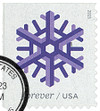
# 5031 - 2015 First-Class Forever Stamp - Geometric Snowflakes: Purple
U.S. # 5031
2015 49¢ Purple Snowflake
Geometric Snowflakes
Holiday Celebrations
Flurries, squalls, snowstorms, nor’easters, snow bursts... all can drop significant amounts of white fluffy precipitation from the sky, but none are blizzards by definition.
To qualify as a blizzard, winds of at least 35 miles per hour must accompany snow falling for at least three straight hours with visibility decreased to under a quarter mile. Anything less is just snowfall. But with the right conditions even plain old snowfall can escalate into a full-blown blizzard.
Blizzards are feared not only for the dangerous conditions they create, but also for the aftermath of these brutal storms. Downed power lines and outages often follow in the wake of a blizzard. Bitter temperatures and limited heating solutions can cause frozen and burst pipes, leading to flooding and property damage. Significant snowfall often accompanies these storms, causing roadways to become slippery, obstructed or even completely impassable. Roofs may collapse under heavy snow and the stress of shoveling has been known to cause heart attacks.
Modern meteorology cannot decrease the severity of blizzards. But, luckily, the ability to predict such storms can lessen the impact on those stuck in its path.
Each of the 2015 Snowflake stamps pictures a different type of snowflake in a different color. They were designed by Antonio Alcalá and Leslie Badani.
On October 27, 1986, Great Basin National Park was established in Nevada. The park protects ancient bristlecone pines, Wheeler Peak Glacier, and more. Some of the earliest-known Paleo-Indians in the Great Basin arrived as early as 10,000 BC. Archaeological evidence shows the area had regular inhabitants for several thousand years that included the Shoshone, Ute, Mono, and Northern Paiute. The Fremont Indians, who lived in the Great Basin from about 1000 to 1300 AD, left behind a legacy of rock art in Upper Pictograph Cave. Within the cave’s walls are several drawings picturing humans, animals, and abstract designs. Evidence of the Fremont in the region disappeared around 1500 AD, with their departure likely due to the arrival of other tribes. Among these new tribes were the Shoshone, whose descendants still live in the area today. Trappers such as Jedediah Smith and Captain John Fremont, leading a military expedition, were among the first to travel across Nevada in the early 1800s. By the 1850s, mail and pony express stations began to enter the area as well as immigrants traveling to California. The Great Basin’s first white settler arrived around 1855 to establish a ranch. As gold, silver, and other valuable minerals were discovered, more and more people flocked to the area. The movement to protect America’s natural resources began in the mid-1800s. By 1905, the United States Forest Service was established and its chief, Gifford Pinchot, turned his attention to central eastern Nevada. He grew concerned over the remaining timber supply and wanted to protect it from fire and exploitation. Pinchot also recognized the need to conserve the local watersheds and avoid overgrazing of the fields. The following year, Pinchot sent a surveyor to the area who concluded that four national forests be established (two of which later became part of Great Basin National Park). The surveyor also reported that most of the settlers were in favor of the national forest, as it would protect their timber and water, while the shepherds opposed it. On February 10, 1909, President William Howard Taft created the Nevada National Forest (with roughly the same boundaries as the proposed forest reserve). A new highway opened near the Lehman Caves in July 1920, bringing new interest to the area. On a visit to the caves the following year, Cada C. Boak, who had been influential in building the new road, was one of the first people to suggest establishing a National Monument to protect the caves. After lengthy correspondence with the National Park Service, Boak’s suggestion was approved. On January 24, 1922, President Warren G. Harding officially established the Lehman Caves National Monument.Great Basin National Park

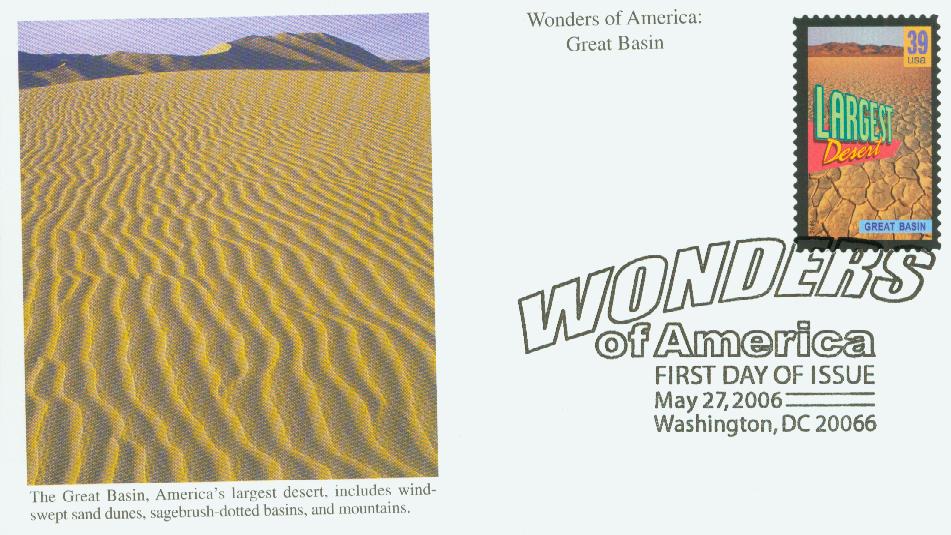
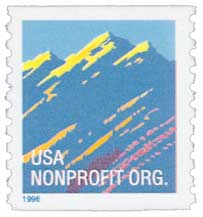
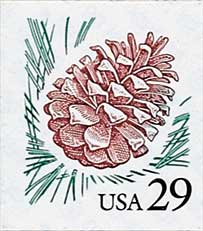
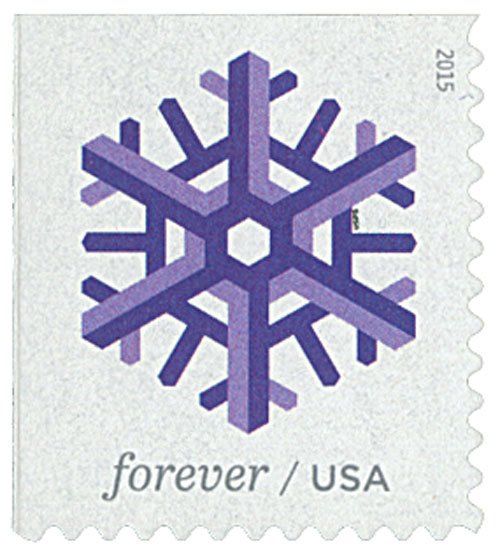
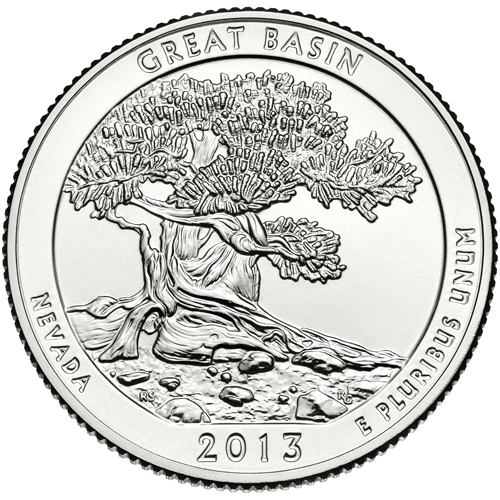
The first talks of making the area a National Park came in 1955. County officials supported the idea, believing it would increase publicity and tourism, creating a new source of income as the local mining industry was unpredictable. Another driving force behind establishing a park was the discovery of the Wheeler Ice Field. Despite having the support of the National Park Service, the movement was hindered by the National Forest Service, which formed the Wheeler Peak Scenic Area in 1959, comprising much of the land planned for the national park. After several years of tension, debates, and court proceedings, the 76,000-acre Great Basin National Park was established when President Ronald Reagan signed it into law on October 27, 1986.
Value: 49¢ 1-ounce first-class letter rate
Issued: October 23, 2015
First Day City: New York, NY
Type of Stamp: Commemorative
Printed by: Banknote Corporation of America for Sennett Security Products
Method: Offset printing in double-sided booklets 20
Perforation: Serpentine Die Cut 11 ¼ x 10 ¾
Self-Adhesive
Quantity Printed: 75,000,000 stamps
Snowflake stamps have proved a popular wintertime favorite since the first set was issued in 2006 in four different formats (U.S. #4101-16). There was also a set of four snowflake stamps issued in 2013 (U.S. #4808-12)
U.S. # 5031
2015 49¢ Purple Snowflake
Geometric Snowflakes
Holiday Celebrations
Flurries, squalls, snowstorms, nor’easters, snow bursts... all can drop significant amounts of white fluffy precipitation from the sky, but none are blizzards by definition.
To qualify as a blizzard, winds of at least 35 miles per hour must accompany snow falling for at least three straight hours with visibility decreased to under a quarter mile. Anything less is just snowfall. But with the right conditions even plain old snowfall can escalate into a full-blown blizzard.
Blizzards are feared not only for the dangerous conditions they create, but also for the aftermath of these brutal storms. Downed power lines and outages often follow in the wake of a blizzard. Bitter temperatures and limited heating solutions can cause frozen and burst pipes, leading to flooding and property damage. Significant snowfall often accompanies these storms, causing roadways to become slippery, obstructed or even completely impassable. Roofs may collapse under heavy snow and the stress of shoveling has been known to cause heart attacks.
Modern meteorology cannot decrease the severity of blizzards. But, luckily, the ability to predict such storms can lessen the impact on those stuck in its path.
Each of the 2015 Snowflake stamps pictures a different type of snowflake in a different color. They were designed by Antonio Alcalá and Leslie Badani.
On October 27, 1986, Great Basin National Park was established in Nevada. The park protects ancient bristlecone pines, Wheeler Peak Glacier, and more. Some of the earliest-known Paleo-Indians in the Great Basin arrived as early as 10,000 BC. Archaeological evidence shows the area had regular inhabitants for several thousand years that included the Shoshone, Ute, Mono, and Northern Paiute. The Fremont Indians, who lived in the Great Basin from about 1000 to 1300 AD, left behind a legacy of rock art in Upper Pictograph Cave. Within the cave’s walls are several drawings picturing humans, animals, and abstract designs. Evidence of the Fremont in the region disappeared around 1500 AD, with their departure likely due to the arrival of other tribes. Among these new tribes were the Shoshone, whose descendants still live in the area today. Trappers such as Jedediah Smith and Captain John Fremont, leading a military expedition, were among the first to travel across Nevada in the early 1800s. By the 1850s, mail and pony express stations began to enter the area as well as immigrants traveling to California. The Great Basin’s first white settler arrived around 1855 to establish a ranch. As gold, silver, and other valuable minerals were discovered, more and more people flocked to the area. The movement to protect America’s natural resources began in the mid-1800s. By 1905, the United States Forest Service was established and its chief, Gifford Pinchot, turned his attention to central eastern Nevada. He grew concerned over the remaining timber supply and wanted to protect it from fire and exploitation. Pinchot also recognized the need to conserve the local watersheds and avoid overgrazing of the fields. The following year, Pinchot sent a surveyor to the area who concluded that four national forests be established (two of which later became part of Great Basin National Park). The surveyor also reported that most of the settlers were in favor of the national forest, as it would protect their timber and water, while the shepherds opposed it. On February 10, 1909, President William Howard Taft created the Nevada National Forest (with roughly the same boundaries as the proposed forest reserve). A new highway opened near the Lehman Caves in July 1920, bringing new interest to the area. On a visit to the caves the following year, Cada C. Boak, who had been influential in building the new road, was one of the first people to suggest establishing a National Monument to protect the caves. After lengthy correspondence with the National Park Service, Boak’s suggestion was approved. On January 24, 1922, President Warren G. Harding officially established the Lehman Caves National Monument.Great Basin National Park






The first talks of making the area a National Park came in 1955. County officials supported the idea, believing it would increase publicity and tourism, creating a new source of income as the local mining industry was unpredictable. Another driving force behind establishing a park was the discovery of the Wheeler Ice Field. Despite having the support of the National Park Service, the movement was hindered by the National Forest Service, which formed the Wheeler Peak Scenic Area in 1959, comprising much of the land planned for the national park. After several years of tension, debates, and court proceedings, the 76,000-acre Great Basin National Park was established when President Ronald Reagan signed it into law on October 27, 1986.
Value: 49¢ 1-ounce first-class letter rate
Issued: October 23, 2015
First Day City: New York, NY
Type of Stamp: Commemorative
Printed by: Banknote Corporation of America for Sennett Security Products
Method: Offset printing in double-sided booklets 20
Perforation: Serpentine Die Cut 11 ¼ x 10 ¾
Self-Adhesive
Quantity Printed: 75,000,000 stamps
Snowflake stamps have proved a popular wintertime favorite since the first set was issued in 2006 in four different formats (U.S. #4101-16). There was also a set of four snowflake stamps issued in 2013 (U.S. #4808-12)




